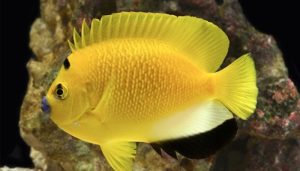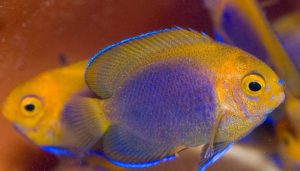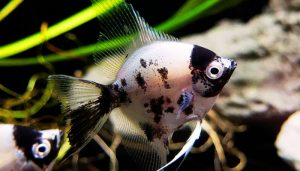Freshwater Angelfish tank setup Ideas: in the planted tank world, Setting up a thriving angelfish tank is both an exciting and rewarding endeavor for aquarium enthusiasts. Known for their striking beauty and graceful movements, angelfish are a popular choice among hobbyists.
However, creating the ideal environment for these tropical fish requires careful planning and attention to detail.
From selecting the right tank size and aquarium water conditions to incorporating suitable decorations and plants, each element plays a crucial role in ensuring the health and happiness of your angel fish.
Additionally, if you’re interested in breeding these stunning fish, understanding their unique behaviors and requirements is essential for success.

In this article, we’ll explore essential tank set up tips, including optimal water parameters, tank mates, and the best breeding practices to help you foster a thriving angelfish community.
Whether you’re a beginner or a seasoned aquarist, these insights will enhance your experience and deepen your appreciation for these captivating creatures.
Table of Contents
ToggleAre Angelfish Difficult to Keep?
Angelfish are often considered a moderate challenge for aquarists, especially for beginners. While they are hardy and can adapt to various conditions, they have specific needs that must be met to thrive.
These fish are inquisitive and require an environment where they can swim freely. If their tank set up is not conducive to their behavior, they may exhibit signs of stress or aggression. Proper care includes maintaining water quality and temperature, which can be a learning curve for new fishkeepers.

Additionally, angel fish can be territorial, particularly when they are breeding. This means that choosing suitable tankmates is crucial to avoid aggression.
When stocking a community tank, it’s advisable to select peaceful species that can coexist with angelfish. Overall, while angel fish are great for beginners, a commitment to learning about their needs is essential for successful fishkeeping.
Best Angelfish tank setup Ideas:
Setting up an angelfish tank that look great, requires careful planning to create a healthy and visually appealing environment. Here are some ideas:
Tank Size & Set up
- Tank Size: A minimum of 20 gallons for a pair, but 55+ gallons is ideal for a small group.
- Tank Shape: Angelfish are tall, so choose a taller tank rather than a long, shallow one.
Filtration & Water Parameters
- Filter: A sponge filter or a canister filter with gentle flow (angel fish dislike strong currents).
- Water Conditions:
- Tank Temperature: 75-82°F (24-28°C)
- pH: 6.5-7.5
- Hardness: 3-8 dGH
- Regular weekly water changes (20-30%) to keep water clean.
Substrate & Decorations
- Substrate: Sand or fine gravel (dark-colored substrate enhances their colors).
- Plants:
- Tall plants like Amazon swords, java fern, Vallisneria, or Anubias for hiding spots.
- Floating plants like frogbit or duckweed for shade.
- Hardscape:
- Driftwood and rock formations for a natural feel.
- Caves or vertical decorations to mimic their natural environment.
Tank Mates
- Compatible fish:
- Tetras (Cardinal, Rummy Nose, Black Skirt)
- Corydoras Catfish
- Plecos (Bristlenose)
- Gouramis
- Avoid:
- Fin-nippers (Tiger Barbs)
- Small fish (they may become food)
- Aggressive fish (Cichlids, except for peaceful species)
Lighting & Background
- Soft lighting (adjustable LED lights) to mimic their natural habitat.
- Background: A black or dark blue background enhances their appearance.
Special Features
- Breeding Setup: If breeding, provide a flat rock or broad-leaf plant for egg-laying.
- Bubble Wall or Airstone: Adds oxygen and a nice aesthetic.
What Décor Do Angelfish Like in Their Tank?
Angelfish appreciate a variety of décor that mimics their natural habitat. They enjoy having hiding places and structures to explore, which can be achieved by using driftwood, rocks, and plants.

These cichlids are particularly fond of floating plants, as they provide shade and security. The use of slate is also beneficial, as it allows angelfish to lay eggs in a safe and secure environment, minimizing the risk of predation.
When decorating the tank, it’s essential to maintain open swimming spaces. Angelfish need room to swim freely, so avoid overcrowding the tank with too many decorations.
A good balance between décor and open space will encourage natural behaviors and reduce aggression. Furthermore, using plants that have broad leaves can give angelfish the cover they desire while still allowing ample swimming space. This thoughtful approach to tank décor will create a thriving environment for your fish.
How to Setup a Freshwater Angelfish Tank
Setting up a freshwater angelfish tank requires careful planning and execution. First, select an appropriate aquarium size, such as a 29 gallon tank, to accommodate your fish’s needs. Begin by establishing a substrate that supports plant growth, as angelfish thrive in well-planted tanks.
After adding the substrate, arrange driftwood and rocks to create hiding spots and territories. This set up will help reduce aggression among tankmates and encourage natural behaviors.
Next, introduce aquatic plants that are suitable for angel fish, ensuring they provide both cover and open swimming spaces. Floating plants are particularly beneficial as they can create shaded areas. Once the tank is decorated, fill it with dechlorinated water and set up a reliable filtration system to maintain slow moving water. Monitor water parameters regularly, as angelfish prefer slightly acidic to neutral pH levels. Finally, allow the tank to cycle before introducing your fish to ensure a stable environment. A well-planned setup will provide a beautiful and healthy home for your angels fish.
Commonly Asked Questions about Angelfish Breeding Tank Setup (FAQs)
What type of tank setup is best for angelfish?
Angelfish are inquisitive and thrive in especially well-planted tanks. Angel fish tank set up that includes tall plants and enough space for them to swim among is ideal. A tank of at least 48 inches is recommended to give them room to behave so well.
What should I include in a community stocking scheme with angelfish?
When creating a community stocking scheme, it is important to choose tank mates that are suited to angels. Avoid keeping them with small fish, as angelfish are carnivorous fish and might eat them. Instead, opt for larger fish that can coexist peacefully.
How do I create a breeding pair of angelfish?
To establish a breeding pair, it is best to keep multiple pairs in a separate breeding tank. Given this background, observe which two fish develop a bond, as they will likely spawn together. Ensure the tank is full of personality and has hiding spots.
What plants should I choose for an angelfish tank?
Angelfishes are members of the family Cichlidae and prefer environments that mimic their natural habitat. You can find aquatic plants that are suited to angels, including tall plants. They’re also thin and allow for swimming space while providing cover.
How do angelfish behave when spawning?
During spawning, angelfish will exhibit unique behaviors, especially when spawning. They will often guard their eggs and create a territory around their breeding site. This is a good time to observe their full of personality interactions.
Can angelfish eat their fry?
Yes, angel fish can also eat fry if given the chance. It’s important to separate the fry from the parents if you want to raise them, as angel fish might see them as food.
What is the ideal water temperature for angelfish?
The ideal water temperature for angelfish typically ranges from 24 to 28 degrees Celsius. Keeping the water parameters stable will ensure that your fish remain healthy and active.
How much do angelfish need to eat?
They should be fed a varied diet that includes high-quality pellets, flakes, and occasional frozen or live foods. They’re known to eat well, and feeding them a balanced diet will help promote their health and color.
What are some signs of stress in angelfish?
Signs of stress in angel fish include hiding, a lack of appetite, or erratic swimming patterns. If you notice these behaviors, it may indicate that the tank conditions need to be improved or that they’re feeling threatened by tank mates.
Conclusion
In conclusion, setting up an angelfish tank can be a fulfilling venture that allows you to enjoy these elegant cichlids in your home. While angel fish can be a moderate challenge, understanding their specific needs will greatly enhance your success as a fishkeeper. From selecting the right tank size and décor to ensuring suitable tankmates, every aspect contributes to the overall well-being of your angelfish. With proper care and attention, you can create a thriving aquarium that showcases the beauty and personality of these remarkable fish.
By investing time in learning about Angelfish tank setup, you will not only provide a comfortable environment for your angel fish but also enjoy the rewards of breeding and watching them flourish. The journey of keeping angelfish is not just about maintaining a tank; it’s about creating a vibrant aquatic ecosystem that brings joy and serenity to your life. Embrace the adventure, and let your angelfish thrive!
Recommended posts
- Full Grown Angelfish: Size, Care, and Tank Requirements
- Best Angelfish Plants for Happy Fish – Aquarium Care Tips
- Breeding of Angelfish – A Complete Guide for Beginners
- Angelfish Tank Size Guide – Ideal Space for Your Fish
- How Big Do Angel fish Get? Discover Their Maximum Size & Growth
- Angelfish Size Explained: What to Expect as They Grow!
- Are Angelfish Saltwater Fish? Discover Their Ideal Habitat
- How Many Angelfish for a 55 Gallon Tank: (The Secret Formula)
- Angelfish Fin Rot Treatment: Step-by-Step Recovery Guide
- Peruvian Altum Angelfish Care Guide – Habitat & Tank Setup
- Keeping Angelfish in Community Tank: Best Tips & Tankmates
- Keeping Angelfish with Gouramis: Compatibility, Tips & Setup
- Angelfish Eggs Hatch Time: How Long It Takes & What to Do
- Exploring the Freshwater Angelfish Natural Habitat: Rivers & Ecosystems
- Angelfish Eggs Turned White? Common Reasons & Prevention
- Angelfish Emperor: A Complete Guide for Beginners
- Black Lace Angelfish Care Guide: (Tips for Thriving Angels)




